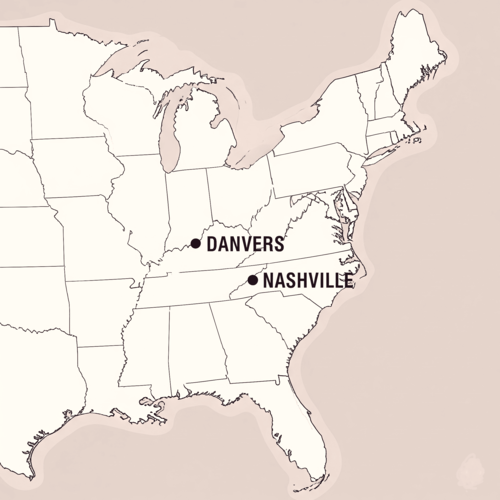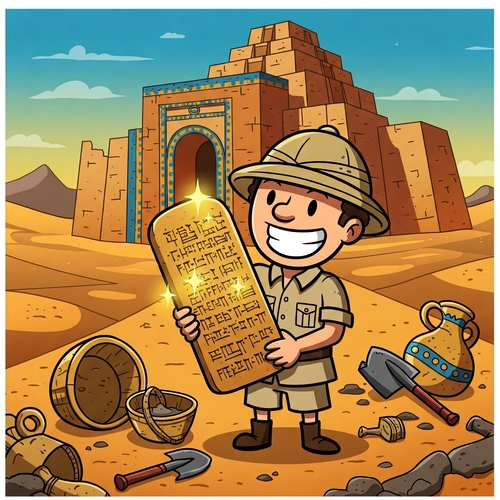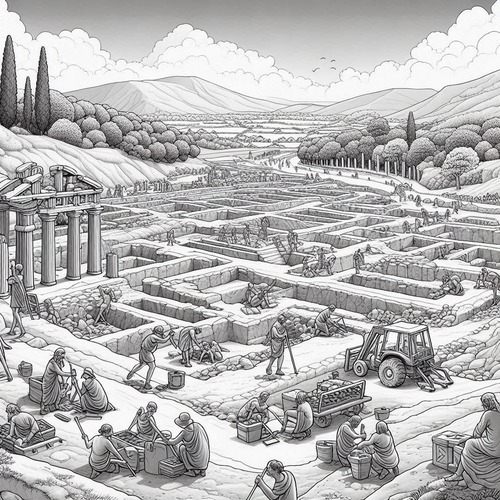Digging Up Truth: How Babylon’s Ruins Validate Scripture
For centuries, sceptics have questioned the historical accuracy of the Bible, particularly its accounts of ancient civilisations and events. Yet as archaeologists continue to excavate sites across the Middle East, they’re uncovering compelling evidence that authenticate Bible narratives. Nowhere is this more evident than in the ruins of ancient Babylon, once the centre of world power and prominently featured throughout Scripture.
FROM BABEL TO EMPIRE: BABYLON’S RUINS VALIDATE SCRIPTURE
The Bible first mentions Babylon in Genesis 11 as “Babel,” where humanity attempted to build a tower reaching the heavens. Archaeological excavations have uncovered massive ziggurats (stepped pyramids) throughout Mesopotamia, with Babylon’s Etemenanki being one of the most impressive. Standing approximately 300 feet tall, this massive structure aligns remarkably with the Biblical description of a tower built by people who said, “Come, let us build ourselves a city, with a tower that reaches to the heavens.”
Linguistic evidence further supports this connection, as “Babel” derives from the Akkadian “bab-ili,” meaning “gate of god” – the same meaning as the Greek “Babylon.” This etymological connection bridges the Biblical account with historical reality.
Archaeological evidence reveals Babylon’s growth from a small Akkadian city to the magnificent capital described in Scripture. Clay tablets dating to the 18th century BCE mention early Babylonian kings, confirming the antiquity of this civilization exactly as the Bible suggests.
NEBUCHADNEZZAR AND BIBLICAL ACCURACY
The Bible extensively describes Nebuchadnezzar II’s Babylon, particularly in Daniel and Jeremiah. Archaeological discoveries have stunningly confirmed these accounts.
The massive Ishtar Gate, now reconstructed in Berlin’s Pergamon Museum, validates Biblical descriptions of Babylon’s splendour. Its blue-glazed bricks and relief images of lions, bulls, and dragons (symbols of Babylonian gods) demonstrate the advanced architectural techniques and religious symbolism described in Daniel.
The Babylonian Chronicles, clay tablets discovered in the late 19th century, confirm the exact timeline of Nebuchadnezzar’s conquest of Jerusalem in 597 BCE, precisely matching the Biblical account in 2 Kings 24. These tablets specifically mention Jehoiachin, king of Judah, providing independent verification of Biblical figures.
Nebuchadnezzar’s Inscriptions: Perhaps most remarkable is the discovery of Nebuchadnezzar’s own inscriptions boasting about his building projects: “I made Babylon into a fortress… I decorated it with gold, silver, precious stones… I built a palace of jubilation and rejoicing.” These words echo descriptions in Daniel 4:30, where Nebuchadnezzar declares, “Is not this the great Babylon I have built as the royal residence, by my mighty power and for the glory of my majesty?”
DAILY LIFE IN BIBLICAL BABYLON CONFIRMED
Thousands of cuneiform tablets uncovered from Babylon reveal a sophisticated economic system involving contracts, receipts, and legal documents – precisely the environment described in the book of Daniel, where Jewish exiles navigated Babylonian society while maintaining their faith.
Archaeological discoveries show evidence of the multicultural society described in Daniel, with records of various ethnic groups, including Jews, living in the city. The “Al-Yahudu” tablets document Jewish communities in Babylonian exile, confirming the Biblical account of the Jewish diaspora.
Religious artefacts unearthed in Babylon, including statues of gods like Marduk and Ishtar, correspond to the idolatrous practices condemned by Hebrew prophets. The famous Babylonian creation epic, Enuma Elish, found on clay tablets, provides context for Daniel’s courageous stance against Babylonian religious practices.
PROPHECIES FULFILLED: BABYLON’S PERMANENT DESOLATION
Bible prophecies about Babylon’s fall were remarkably specific. Isaiah 45 predicted Cyrus would conquer Babylon by drying up its waters, and Jeremiah 51:30-32 foretold messengers would report Babylon’s capture to its king.
The Cyrus Cylinder, discovered in 1879, confirms Cyrus the Persian conquered Babylon in 539 BCE by diverting the Euphrates River and entering through water gates—exactly as prophesied. Historical accounts describe messengers running to inform King Belshazzar of the city’s fall during a feast, precisely matching the Biblical account in Daniel 5.
Permanent Desolation Prophesied: Even more striking are the fulfilled prophecies regarding Babylon’s permanent desolation. Isaiah 13:19-20 declared, “Babylon… will never be inhabited or lived in for all generations,” while Jeremiah 51:26 stated, “No stone of you will be taken for a corner and no stone for a foundation, but you will be desolate forever.”
Modern archaeological surveys, including those conducted by Joel Kramer, confirm the prophecy’s fulfillment. Despite numerous attempts throughout history to rebuild Babylon—including efforts by Alexander the Great and Saddam Hussein—the ancient city remains uninhabited. Groundwater issues make the site unsuitable for rebuilding, and the ruins stand desolate in modern-day Iraq, precisely as Scripture predicted thousands of years ago.
BABYLON’S RUINS VALIDATE SCRIPTURE: RECENT DISCOVERIES
Technological advancements have enabled archaeologists to make even more significant discoveries in recent decades.
- Satellite imagery has revealed the full extent of ancient Babylon’s urban planning, confirming Biblical descriptions of its massive scale.
- Recent excavations, including those by Joel Kramer, have documented the exact path of Babylon’s fall to the Persians, including evidence of burned gates and strategic breaches in the city walls. These findings align perfectly with prophecies in Jeremiah and Isaiah.
- Translations of cuneiform tablets from the “Sippar Collection” include administrative records listing rations provided to “Yaukin, king of Judah” (Jehoiachin) and his sons—direct archaeological confirmation of the Bible’s account in 2 Kings 25:27-30, which describes the captive Judean king receiving a daily allowance in Babylon.
- Ground-penetrating radar surveys have identified structures beneath Babylon’s ruins that correspond to buildings mentioned in Biblical accounts, including what may be the foundations of administrative complexes where Daniel and other Jewish exiles would, probably, have worked.
WHERE SCHOLARSHIP STANDS TODAY
While some scholars once dismissed Bible accounts of Babylon as mythology, archaeological evidence has shifted academic consensus. Renowned archaeologist William F Albright noted, “Discovery after discovery has established the accuracy of innumerable details in the Bible as a source of history.”
The collaborative work between archaeologists and Biblical scholars continues to yield insights that bridge ancient texts with physical evidence. As technology advances, we can expect even more discoveries validating Scripture’s historical reliability.
THE STONES STILL SPEAK: BABYLON’S RUINS VALIDATE SCRIPTURE
The ruins of Babylon stand today as a testament to the Bible’s historical accuracy. From the tower of Babel to Nebuchadnezzar’s splendour, from the Jewish exile to Babylon’s ultimate desolation, archaeological discoveries continue to authenticate Bible narratives.
The findings don’t just validate Scripture—they bring it to life, allowing us to visualise the world in which these ancient events unfolded. As we examine the physical evidence unearthed from Babylon’s dust, we discover science and faith aren’t adversaries but companions on the journey toward understanding our past.
BABYLON’S RUINS VALIDATE SCRIPTURE: RELATED FAQs
Is the Hebrew name for Babylon in the Old Testament the same as Babel in Genesis? Yes, the Hebrew word “Babel” is used interchangeably for both the Tower of Babel in Genesis and the later city of Babylon throughout the Old Testament. This linguistic consistency suggests the biblical writers understood Babel and Babylon to be the same location, just at different historical periods, reinforcing the connection between the Genesis account and later historical events.
- How does the discovery of tablet with the inscription, “Yaukin, King of Judah” in Babylonian records demonstrate God’s faithfulness to David’s dynasty? The Babylonian ration tablets mentioning “Yaukin” (Jehoiachin) confirm that despite being in exile, David’s descendant was still recognised as “King of Judah” even by his captors. This preservation of the royal line during exile directly fulfils God’s covenant with David in 2 Samuel 7:16 that “your house and your kingdom will endure forever,” ensuring the Davidic lineage continued unbroken through the exile until it ultimately led to Jesus Christ.
- What evidence exists of Daniel’s position in Nebuchadnezzar’s court as described in the Bible? Archaeological excavations have uncovered administrative quarters in Babylon with tablets listing foreign officials serving in the royal administration, matching Daniel’s described role. Several clay seal impressions (bullae) have been found bearing names of officials with positions similar to those mentioned in Daniel. And Babylonian court protocols described in recovered documents align remarkably with the customs and hierarchies depicted in the Biblical narrative.
How do the discoveries at Babylon compare to archaeological findings in Jerusalem from the same period? Excavations in Jerusalem’s City of David have revealed a thick layer of ash and destruction debris dating precisely to 586 BCE, matching the Babylonian destruction described in 2 Kings 25. Archaeologists have discovered Babylonian arrowheads embedded in this destruction layer, along with burned timber and crushed storage jars, providing physical evidence that corroborates both the Jerusalem and Babylon sides of the same historical event.
- What do the Babylonian astronomical tablets reveal about Bible chronology? Babylonian astronomical diaries, which record celestial events with precise dating, have helped scholars establish an absolute chronology for key Bible events mentioned in relation to Babylonian kings. These tablets document eclipses and planetary positions that can be calculated backward with modern astronomy, confirming dates for events like Nebuchadnezzar’s conquest of Jerusalem and the beginning of the Jewish exile with remarkable precision.
- How did Saddam Hussein’s attempts to rebuild Babylon ultimately fail? Saddam Hussein spent millions in the 1980s constructing a replica palace atop Babylon’s ruins and attempting to rebuild ancient structures using modern bricks stamped with his name. After his fall, UNESCO determined these reconstructions actually damaged the authentic site, and rising groundwater has caused structural issues in the reconstructions, demonstrating the continuing fulfillment of prophecies about Babylon remaining uninhabited despite modern attempts to defy them.
What evidence exists of Jewish religious practices continuing during the Babylonian exile? Clay tablets discovered near the Ishtar Gate document Jewish communities maintaining distinctive names, observing Sabbaths, and following dietary restrictions while in exile. Archaeologists have uncovered small ritual objects and prayer inscriptions in Jewish quarter ruins that show adherence to religious practices, confirming Biblical descriptions of figures like Daniel maintaining their faith despite pressure to assimilate into Babylonian culture.
BABYLON’S RUINS VALIDATE SCRIPTURE: OUR RELATED POSTS
- Tower of Babel: Historical Evidence Supports Bible Account
- End-Time Babylon: Cracking the Prophetic Mystery
- At Pentecost: God Fulfils Covenant and Reverses Babel
Editor's Pick

Should We Stop Using Male Pronouns for God? Why Do We Say No?
A friend of ours arrived eagerly at his first theology class in seminary. But he quickly discovered something troubling: the [...]

Did Old Testament Law Force Women to Marry their Rapists?
**Editor’s Note: This post is part of our series, ‘Satan’s Lies: Common Deceptions in the Church Today’… Viral misinformation abounds [...]

From Danvers To Nashville: Two Statements, One Biblical Vision
30 years separate the Danvers Statement on Biblical Manhood and Womanhood (1987) and the Nashville Statement on Human Sexuality (2017). [...]

The Nashville Statement: Why Affirm It Despite Media Backlash?
WHY DO REFORMED CHRISTIANS STAND BY THIS STATEMENT ON MARRIAGE AND GENDER? When the Nashville Statement was released in 2017, [...]

Who Is Belial? Solving The 2 Corinthians 6:15 Mystery
Belial: This name from the pages of Scripture chills the soul. Who is this mysterious figure Paul invokes in 2 [...]

Celibacy Or Castration: What Jesus Really Means in Matthew 19:12
One of Scripture's most shocking misinterpretations led theologian Origen to castrate himself in the third century. His tragic mistake? Taking [...]

Philippians 4:13: Did Paul Really Mean We Can Do ALL Things?
"I can do all things through Christ who strengthens me." It's on gym walls, graduation cards, and motivational posters everywhere. [...]

The Ordinary Means of Grace: Why Are They Indispensable?
ORDINARY MEANS FOR EXTRAORDINARY TRANSFORMATION What if God's most powerful work in believers' lives happens through the most ordinary activities? [...]

Is the Bible God’s Word? Or Does It Only Contain God’s Word?
The authority of Scripture stands at the crossroads of modern Christianity. While some argue the Bible merely contains God’s Word [...]

Will We Remember This Life in Heaven? What Isaiah 65:17 Means
"Will I remember my spouse in heaven? My children? Will the joy we shared on earth matter in eternity?" These [...]
SUPPORT US:
Feel the Holy Spirit's gentle nudge to partner with us?
Donate Online:
Account Name: TRUTHS TO DIE FOR FOUNDATION
Account Number: 10243565459
Bank IFSC: IDFB0043391
Bank Name: IDFC FIRST BANK






